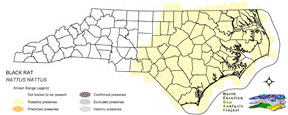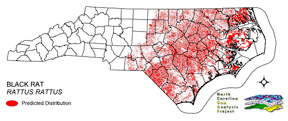
| Taxa: |
| Order: |
| Family: |
| Mammalia |
| Rodentia |
| Muridae |
| NatureServe Global Rank: |
| NatureServe State (NC) Rank: |
| G5 |
| SE |
| Federal Status: |
| NC State Status: |
| --- |
| --- |


| Land Unit |
| US Fish & Wildlife Service |
| US Forest Service |
| US National Park Service |
| US Department of Defense |
| NC State Parks |
| NC University System |
| NC Wildlife Res. Com. |
| NC Forest Service |
| NC Div. of Coastal Mgmt. |
| Local Governments |
| Non-Governmental Org. |
| Other Public Lands |
| Private Lands |
| GAP Status 1-2 |
| All Protected Lands |
| Statewide |
| Hectares |
| 6,726.42 |
| 981.45 |
| 15,697.80 |
| 288.90 |
| 980.28 |
| 1,205.46 |
| 4,306.23 |
| 711.18 |
| 34.74 |
| 488.61 |
| 1,126.62 |
| 2,121.93 |
| 2,581,647.75 |
| 11,183.49 |
| 33,725.16 |
| 2,616,317.37 |
| Acres |
| 16,621.34 |
| 2,425.22 |
| 38,790.10 |
| 713.89 |
| 2,422.32 |
| 2,978.76 |
| 10,640.92 |
| 1,757.36 |
| 85.84 |
| 1,207.38 |
| 2,783.94 |
| 5,243.40 |
| 6,379,389.28 |
| 27,635.00 |
| 83,336.67 |
| 6,465,059.76 |
| % of Dist. on |
| Prot. Lands |
| 19.9 % |
| 2.9 % |
| 46.4 % |
| 0.9 % |
| 2.9 % |
| 3.6 % |
| 11.2 % |
| 2.1 % |
| 0.1 % |
| 3.2 % |
| 3.2 % |
| 5.5 % |
| < 0.1 % |
| 33.2 % |
| ----- |
| ----- |
| % of Dist. on |
| All Lands |
| 0.3 % |
| < 0.1 % |
| 0.6 % |
| < 0.1 % |
| < 0.1 % |
| < 0.1 % |
| 0.2 % |
| < 0.1 % |
| < 0.1 % |
| < 0.1 % |
| < 0.1 % |
| < 0.1 % |
| 98.7 % |
| 0.4 % |
| ----- |
| ----- |
|
An exotic species, the black rat was introduced to North America from Europe during the early days of maritime commerce (Lee et al. 1982). It can occur anywhere in North Carolina, but populations are uncommon to rare and localized where they exist. Social animals, black rats occur as colonies in human dominated landscapes from inner cities to rural farms (Whitaker and Hamilton 1998). The rat is found in cities and in buildings, homes and other structures of urban and rural areas. It is particularly numerous at ports and shipyards, where populations may be continually reinforced by immigrants from disembarking ships (Lee et al. 1982). The black rat is a better climber than the more dominant Norway rat (Whitaker and Hamilton 1998). Thus, where both species are present, the black rat typically occupies roofs and upper levels of buildings while the Norway rat typically controls ground and subterranean levels. Tree cavities are also used for shelter and nesting. The rat nests in secluded nooks and crannies of buildings (Whitaker and Hamilton 1998). In southern portions of its range, the rat may also nest in brushy fields and hedgerows adjacent to farmsteads as well as in arboreal situations, such as in tree cavities and among palm leaves (Webster et al. 1985, Whitaker and Hamilton 1998). NATURE SERVE GLOBAL HABITAT COMMENTS: Often associated with humans; buildings, sewers, seaports. In natural habitats in some areas (e.g., Pacific islands [wooded gulches, sugar cane fields, dry and wet forests, coconut palms] and West Indies). In Hawaii (western Mauna Kea), preferred dense tree stands and tall grass over open areas (Amarasekare 1994); abundant in mesic to wet native forest on Maui (Sugihara 1997). Often arboreal. Young are born in nests in protected sites in buildings or within other cover (e.g., ricebird nests in Hawaii, Van Riper 1974; coconut shells, Twibell 1973). |
| Code | Name | Description | NC Natural Heritage Program Equivalent |
| 180 | Agricultural Crop Fields | Farm fields used for row crops. | No equivalent |
| 205 | Agricultural Pasture/Hay and Natural Herbaceous | Farm fields used for pasture grass or hay production, as well as old fields dominated by native and exotic grasses. | No equivalent |
| 202 | Residential Urban | Includes vegetation interspersed in residential areas. Includes lawns, mixed species woodlots, and horticultural shrubs. Vegetation accounts for between 20 - 70% of the cover. | No equivalent |
| 203 | Urban Low-Intensity Developed | Highly developed areas with vegetation accounting for < 20% of the cover. | No equivalent |
| 204 | Urban High-Intensity Developed and Transportation Corridors | Highly developed areas including infrastructure such as roads, railroads. Vegetation represents < 20% of the cover. | No equivalent |
|
Baker, J. K., and M. S. Allen. 1978. Roof rat depredationson HIBISCADELPHUS (Malvaceae) trees. Pages 2-5 in Smith, C. W., editor. Proceedings Second Conference in Natural Sci., Hawaii Volcanoes Natl. Park. Univ. Hawaii Dept. Bot.
Amarasekare, P. 1994. Ecology of introduced small mammals on western Mauna Kea, Hawaii. J. Mamm. 75:24-38. Van Riper, C., III. 1974. Unusual uses of ricebird's nestsin Hawaii. 'Elepaio 35:5. Atkinson, I. A. E. 1977. A reassessment of factors, particularly RATTUS RATTUS (L.), that influenced the declineof endemic forest birds in the Hawaiian Islands. Pacific Science 31:109-133. Wilson, D. E., and D. M. Reeder (editors). 1993. Mammal Species of the World:a Taxonomic and Geographic Reference. Second Edition. Smithsonian Institution Press, Washington, DC. xviii + 1206 pp. Whitaker, J.O. Jr. and W.J. Hamilton, Jr. 1998. Mammals of the eastern United States. Cornell Univ. Press, Ithaca, New York. 583 pp. Lefebvre, L. W., et al. 1989. Relationship of roof rat population indices with damage to sugarcane. Wildl. Soc. Bull. 17:41-45. Zwank, P. J., and B. W. Layton. 1989. Black rats as potential Puerto Rican parrot nest predators. Caribbean J. Sci. 25:13-20. Lee, D. S., L. B. Funderburg Jr., and M. K. Clark. 1982. A distributional survey of North Carolina mammals. Occasional Papers of the North Carolina Biological Survey, No. 1982-10. North Carolina State. Mus. Nat. Hist., Raleigh, North Carolina. 72 pp. Erickson, W. A., R. E. Marsh, and W. L. Halvorson. 1990. A roof rat bait station that excludes deer mice. Wildl. Soc. Bull. 18:319-325. Kramer, R. J. 1971. Hawaiian land mammals. Charles E. Tuttle Co., Rutland, Vermont, and Tokyo, Japan. Banfield, A.W.F. 1974. The mammals of Canada. University of Toronto Press, Toronto. Godin, A.J. 1977. Wild Mammals of New England. Johns Hopkins University Press, Baltimore. 304 pp. Scowcroft, P. G., and H. F. Sakai. 1984. Stripping of ACACIA KOA bark by rats on Hawaii and Maui. Pacific Science38:80-86. Hamilton, William J., Jr., and John O. Whitaker, Jr. 1979. Mammals of the eastern United States. Cornell Univ. Press, Ithaca, New York. 346 pp. Hall, E. R. 1981. The Mammals of North America. Second edition. 2 Volumes. John Wiley and Sons, New York, New York. Schwartz, Charles W., and Elizabeth R. Schwartz. 1981. The wild mammals of Missouri. University of Missouri Press, Columbia. 356 pp. Webster, W. D., J. F. Parnell and W. C. Biggs Jr. 1985. Mammals of the Carolinas, Virginia, and Maryland. The University of North Carolina Press, Chapel Hill, NC. Tomich, P. Q. 1986. Mammals in Hawai'i. A synopsis and notational bibliography. Second edition. Bishop Museum Press, Honolulu. 375 pp. Tomich, P. Q. 1970. Movement patterns of field rodents in Hawaii. Pacific Sci. 24:195-234. Twibell, J. 1973. The ecology of rodents in the Tonga Islands. Pacific Sci. 27:92-98. Buxbaum, K. 1973. Status of the dark-rumped petrel on Maui, 1972. 'Elepaio 34:11-12. |
For more information please contact them at:
NC-GAP Analysis Project
Dept. of Zoology, NCSU
Campus Box 7617
Raleigh, NC 27695-7617
(919) 513-2853
www.basic.ncsu.edu/ncgap